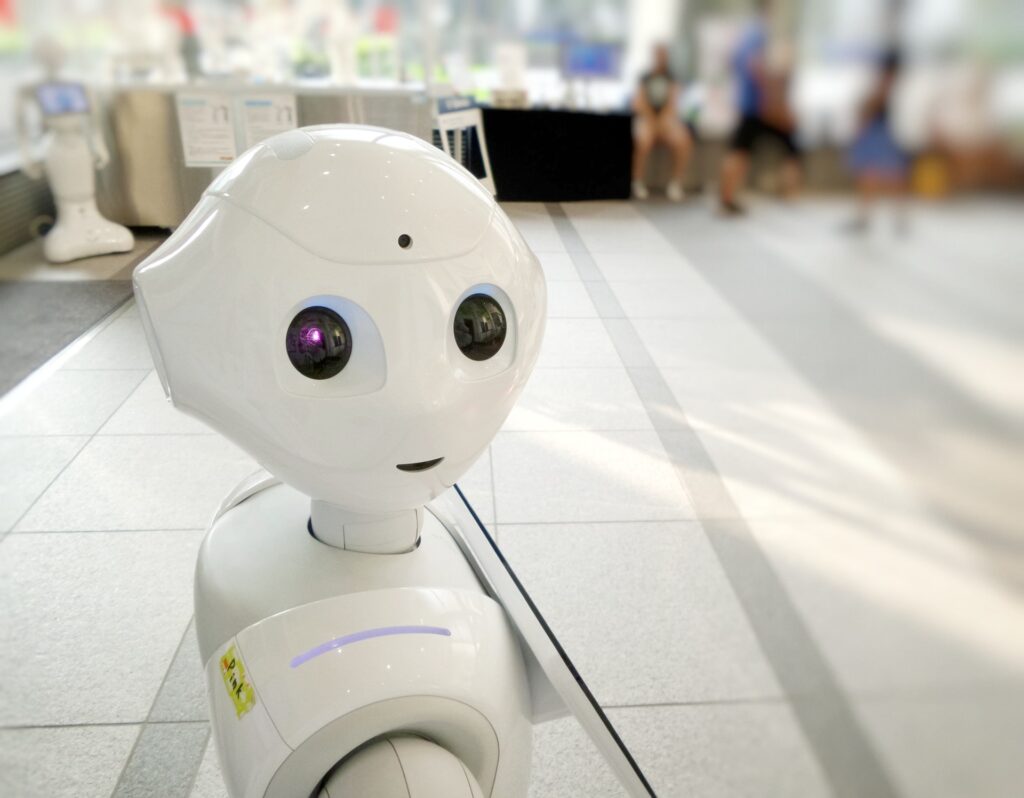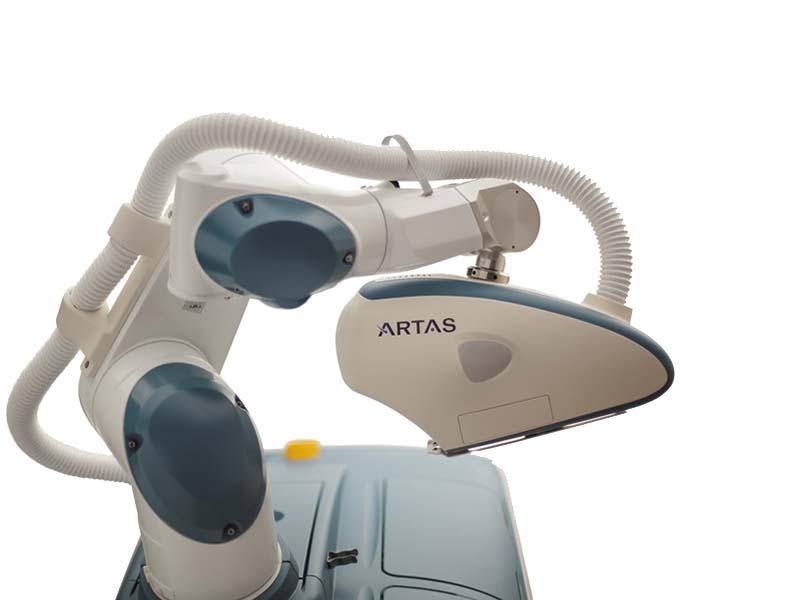
Robots are the way of the future, and automation is reducing the need for physical labor in nearly every sector.
Technologies like the ARTAS robot are leading the way for robotic hair transplants driven by AI and high-precision instruments, with thousands of successful procedures already in the books.
But when it comes to procedures like hair transplants that require a mix of technical expertise and artistry, how do the latest robotics stack up against a surgeon with a steady hand and a keen eye for aesthetics?
Let’s learn about the latest advancements in medical robotics and see how technologies, like ARTAS, perform hair transplants for today’s patients.
More importantly, we’ll explore the pros and cons of these robotic procedures and compare them point-by-point to the manual techniques still utilized by hair surgeons around the world.
With this information, you’ll have everything you need to make an informed decision about your hair transplant strategy and get the results you’ve been looking for.
The science of robotics is not a new phenomenon, nor is hair transplant surgery and the implements involved.
However, the combination of robotics and hair transplant technology has only recently come to the forefront in the medical community. With more hair transplant patients receiving AI-driven procedures, it’s worth learning more about the background of this movement and available options for today’s clients.
Hair transplant technology started in the mid-20th century when robotics was still a science fiction concept by most accounts. What began as essential “hair plugs” soon evolved into less invasive procedures with more aesthetic results.
Robotics did not come into play in the realm of hair restoration until the 21st century arrived, and even in the early years of the new millennium, AI tech was still several steps behind.
However, in this era, research and development teams led by pioneering physicians made marvelous leaps in hair transplant technology, namely the invention of Follicular Unit Excision.
This technique improved upon the foundations of “strip surgery” that came before and would be the framework to which robotic-led surgeries would adhere in the decades to come.
When researching robotic hair transplant, the ARTAS system is likely to appear at the top of your search results online.

The ARTAS technology has been in development since 2006, just as FUE was becoming a leading method for manual hair transplantation.
After undergoing rigorous testing, the system was introduced to the International Society of Hair Restoration Surgeons in 2008. The next several years saw multiple rounds of trials, reviews, and revisions, before the system was brought to commercial markets in 2011.
ARTAS is a large, standalone unit that performs nearly every stage of an FUE hair transplant and automates many of the processes that would otherwise need to be performed by a surgeon and a small group of supporting technicians.
The main function of the unit is to identify follicles units on the scalp with an advanced microscopic readout, providing physicians and clients with a clear visual overlay and possible outcomes for the surgery via the Hair Studio Application.
The system then performs individual extractions at a steady pace for hours at a time, allowing surgeons to process and implant these units as they are harvested from the patient’s donor area.
There is more to the story of what ARTAS technology can and can’t do, and how it compares to the “old-school” ways of performing FUE manually.
This intro to ARTAS can give patients a good idea of what the machine can accomplish and the history behind it all.
Some inventions in the hair restoration field use advanced engineering and robotic mechanisms while still offering surgeons the ability to control the artistic aspects of the procedure.
The NeoGraft system is an example of a crossover technology that partially automates the FUE extraction process, accelerating stages such as graft cutting, removal from the donor area, and the overall efficiency of the harvesting phase of surgery.
NeoGraft and ARTAS differ in the level of involvement required by a surgeon and team of technicians during the transplant process. However, every system has unique attributes that can be customized to the needs of a particular doctor or clinic.
As you research the various robotic hair transplant methods being introduced more frequently in the current era, you’ll encounter iterations of tools and techniques old and new.
Always be sure to identify the exact mechanisms at work, and more specifically, what they offer in terms of results and track records from real patients and physicians.
Keep in mind that as we examine technologies like ARTAS, NeoGraft, and others, we use the term “robotic hair transplantation” in broad strokes.
Every variation of robotic hair transplantation uses unique systems and automates the process to different degrees.
Still, it’s worth comparing the wide range of robotic hair transplant modalities to the manual methods utilized by hair restoration surgeons worldwide. This will help you determine which type of surgery is best for you to pursue, given your circumstances, preferences, and other key factors before you commit.
Pros: Robotic transplantation offers a few vital advantages for anyone seeking FUE-style procedures. The top three are as follows:
Thanks to the advanced scanning and display functionality of the ARTAS system and other AI-based technologies, the client and physician can do a complete analysis of the scalp and visualize the outcome of the surgery before following through.
This gives patients a clear picture of what to expect from their surgery and offers additional insight for surgeons who can confirm the optimal number and placement of follicles from the donor to the target regions of the head.
Robotics like ARTAS can also pinpoint healthy clusters of hair follicles on the back of the head and extract them with precision, leaving less desirable follicle units behind and minimizing waste.
In terms of pure, practical benefits, robotic transplant devices allow for far more efficient surgery than the manual methods used by physicians for decades.
Even with a technique like NeoGraft, which requires some degree of manual precision, the speed of extraction and implantation is vastly accelerated, allowing surgeons and technicians to operate at a faster rate, focus more on factors like quality of placement, the patient experience, and more.
From the client’s perspective, a NeoGraft procedure can be completed up to 20% more quickly than a manual alternative, although ARTAS may be comparable or slower compared to traditional techniques.
Shopping around for FUE procedures will reveal higher prices than you might expect, particularly among the best surgeons in the country.
ARTAS can be utilized by surgeons with less experience to yield similar results across the board, reducing prices and making the surgery more accessible overall.
The typical ARTAS procedure can be had for under $8,000 in most cases, but this price can fluctuate based on the parameters and scope of the surgery, in addition to factors like location, fees, and others.
Cons: While robotic hair transplantation is appealing for several reasons, it’s not without downsides.
Here are three reasons why you may want to avoid this approach in favor of manual hair transplantation by a surgeon.
While ARTAS and other robotic counterparts operate highly efficiently, the main tradeoff happens in terms of graft quality – both in extraction and implantation.
For most patients, sacrificing the quality of their grafts is an instant red flag, especially if they have limited donor area hair to work with.
Transection rates – the rate at which grafts fail to hold in the target region of the scalp – are noticeably higher in both NeoGraft and ARTAS systems.
This doesn’t mean that a hair transplant conducted by robots is always a failure, because thousands of successful surgeries have been accomplished so far.
However, it does mean that for an extra 5% to 10% increase in utilization for donor hair and longer-lasting results, manual FUE is still the gold standard compared to robots.
The outcome of a hair transplantation procedure comes down to a matter of millimeters, and in the case of FUE, manual techniques have the edge in terms of precision over any automated method on the market.
This is because highly skilled surgeons use the smallest available punch size – around 0.7mm or less – to extract follicle units during manual FUE procedures.
NeoGraft and ARTAS, on the other hand, use punch implements that can be up to 50% larger. Even robots don’t have the precision to use the best available tools for the job, which explains why the surgical outcomes are sometimes less than satisfactory for clients.
Speaking of precision, nothing in the universe of robotics and AI can outperform a professional, experienced hair restoration surgeon when the chips are down.
Even with technologies like ARTAS Hair Studio and other advanced tools in the equation, it still remains impossible for robotics to deliver a maximally aesthetic hair transplant that stands the test of time.
While robots may be able to sustain longer surgeries than an actual physician, that’s not the metric that matters most in the hair restoration field.
Precision, artistry, and experience are the essential factors that determine a successful surgery, and those should be a top priority for patients no matter what their goals may be.

Ready to work side by side with a hair restoration expert and achieve the head of hair you’ve always wanted? Here’s why the in-person experience will always be better than the AI alternative.
With systems like ARTAS, FUE is the only available option.
However, it may be the case that an FUE procedure isn’t the best option for your needs, depending on the volume of hair required for your surgery or tolerance for the horizontal scar that is so often associated with FUT strip surgery.
Whether you opt for FUT or FUE, a hair restoration pro will give you the straight facts and set you on the right path.
Once surgery is complete, there is still a recovery period before your hair starts to really look and feel great. Medications, aftercare – it’s all-important.
This is yet another reason why an actual physician and clinic support staff can be so crucial to your overall experience and maximizing results from your procedure.
Ever since Star Wars, we’ve all gone a bit robo-crazy! These transplant techniques might be viable, but they still don’t hold a candle to the real thing – in-person hair transplantations are done manually and with exceptional skill.
Ready to get started? Contact Jae Pak, MD and schedule your consultation today!
Sources:
ARTAS Hair Transplant | Real Self
FUE with ARTAS | Dermatology Online Journal
Photo by Possessed Photography on Unsplash
Speak with Jae Pak, M.D. today!
Request a Consultation